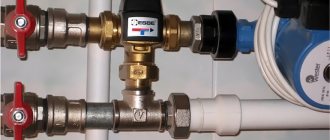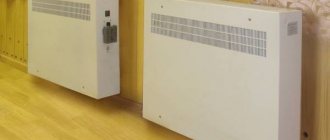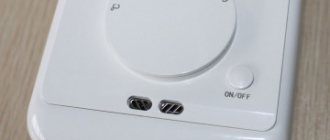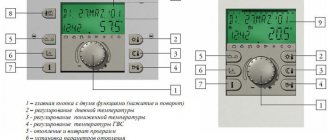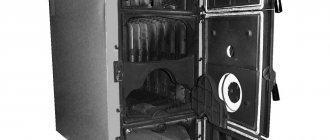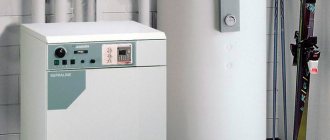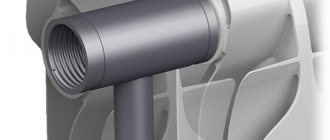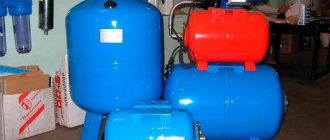The onset of cold weather forces apartment owners to think about ways to additionally heat their homes. One option is to buy a heater. They come in different heating methods, energy sources, and operating principles. In the material “Quartz Heaters,” the site’s editors examined in detail two types of devices that are based on quartz and have the adjective “quartz” in the name, but differ in design and method of heating the room. The volume of work did not allow for a comparative analysis between them.
Let's fill the gap and compare infrared and quartz heaters. At the same time, we clearly distinguish between the devices:
- Quartz heaters include monolithic panels made of pure quartz or with white clay additives (ceramic quartz);
- infrared heaters can be quartz, gas (halogen), diesel, etc. This work considers only quartz infrared devices. To eliminate a little confusion, we will simply call them “infrared heaters.”
Quartz heater
The definition of “quartz heater” includes many heating devices, including heat guns with built-in blocks of mineral elements that retain heat. But these are all tricks of marketers trying to exploit the popularity of classic quartz heating devices, which are a monolithic slab with a heating element built inside.
Structure
In a heating device, the heating element is hermetically sealed in a slab of pure quartz or a mixture with white clay (ceramic-quartz device). To do this, the raw materials are pressed and then sintered in an oven at high temperature. The result is a durable but fragile layer that performs several functions at once:
- prevents oxygen from reaching the heating element - there is no oxidation process during heating;
- accumulates heat like stones in a village bathhouse;
- transmits infrared radiation.
The back wall of the case is covered with a screen that reflects IR rays - the vast majority of manufacturers offer to buy it separately, not including it in the package. Between it and the panel in some models you can find a profiled heat exchanger. A number of manufacturers place the device in a metal case. In general, the design is simple, yet non-separable.
The disadvantage of this structure is the lack of a thermostat. Technologists deliberately do not install it - there is nowhere to mount it. In the case, it will react to the heat of the shell, and when removed at a sufficient distance from the stove, you need a set of a temperature sensor and a thermostat, which must be mounted on a permanent basis. And this is depriving the quartz battery of mobility.
Principle of operation
When operating a quartz heater, two principles of heat transfer are used: convector and wave. In the first case, the device works in the same way as a conventional central heating battery: it heats the air around it, which rises upward, giving way to colder air masses. According to the second method, infrared rays, having overcome the quartz shell, heat the floor, walls, furniture, i.e. everything material encountered on the path of the rays.
The operating algorithm of the device is as follows:
- after switching on, the heating element quickly becomes red-hot and begins to emit infrared rays;
- passing through the quartz shell, the waves give off some of the energy to it, causing the panel to heat up;
- all objects around begin to slowly heat up;
- in 20-30 minutes. the case temperature rises to +95oC (in some models a little higher than +85oC), after which heating starts using the convection method: cold air currents displace warm air. And so in a circle;
- the heated panel practically does not take energy from the wave radiation - IR heating begins to work at full power;
- the surface within the reach of infrared rays slowly warms up;
- heated objects themselves become sources of heat, in turn heating the air around them;
- After the panel is turned off, it cools down for a long time, maintaining a comfortable temperature in the room.
Specifications
Most quartz panels have the following characteristics:
- rated power - 0.4-0.8 kW;
- maximum power – 3.0 kW;
- weight - 12-14 kg;
- linear dimensions - 60x35x2.5 cm;
- cooling rate - 2oC per minute;
- the average efficiency of the device (not to be confused with the beautiful figure of the efficiency of electricity use, which is in the range of 98-99%) is 87-94% (this includes electricity losses from the resistance of the wiring inside the apartment and heating the ceiling);
- case temperature - about +95oC;
- The time it takes for the panel to warm up to the optimal level is 20-30 minutes.
Operating principle of infrared heaters
As already mentioned, the design uses lamps with specific infrared radiation. This radiation is capable of heating surrounding objects in the immediate vicinity due to laminar (constant) heat transfer. Gradually heating up, objects themselves become a source of heat. This is the basic principle of operation of this heater.
Pros and cons of the product
The undoubted advantages include the following characteristics:
- The heater uses a modern heating method, ultraviolet lamps and infrared lamps are energy efficient and require a minimum of electricity;
- Lamp safety. They do not contain mercury vapor or liquid metal, so they can be disposed of as household waste.
The heater has some specific applications in industrial and domestic matters. This forms one “big plus” in comparison with other models. Application Variations:
- Ideal for use in clothes dryers, for example in industrial facilities. The effect of a heat gun is created, but without a moving air flow with heat transfer;
- Used in car paint shops. lamps heat the surface evenly and lead to faster drying;
- For preparing vegetables if they require quick drying;
- Application for some specific repair work. It can become an analogue of a hair dryer for disassembling smartphones, microcircuits and other digital devices.
The disadvantages still prevail:
- When placed in an empty position, this heater will begin to warm up the walls, this does not always lead to success, for example, in a cold room in winter;
- The design of the lamps is fragile and is not designed to withstand impacts when carried;
- The heater does not provide for wall mounting;
- Relatively high price for the model;
- Fragility. The design itself and the infrared lamp lead to the fragility of the device.
Infrared heaters
An infrared heater, also called a reflector, is fundamentally different from a quartz device.
Structure
IR heaters are quartz flasks with a heating element (tungsten, nichrome wire or carbon strips) enclosed in a metal or plastic housing. The front side of the device is open to IR rays. On the reverse side, behind the tubes, a reflector is placed that redirects the radiation towards the room.
With successful focusing, the scattering angle of reflected waves is minimal, which increases the efficiency of the device. Brackets are screwed or soldered on the back wall, allowing you to hang the device on a wall or ceiling anywhere. The schematic diagram of the device can be seen below.
Principle of operation
Infrared heaters use the ability of quartz (SiO2 - silicon dioxide) to transmit electromagnetic waves in the IR radiation range. To do this, a heating element is placed inside the quartz tube, capable of emitting red-hot infrared waves of different lengths (the wavelength depends on the temperature of the spiral - the higher, the longer).
IR rays, meeting an obstacle (floor, furniture, walls, other objects, as well as a person) transfer their energy to it. The surface heats up, becoming in turn a source of heat for the surrounding air. As you can see, unlike central heating radiators and oil radiators, it is not the atmosphere of the room that is initially heated, but the hard surface.
The device works like this:
- after switching on, the spiral becomes red-hot and begins to emit IR rays;
- the surface of objects within the reach of IR radiation heats up;
- the surrounding air is heated from heated walls, floors, furniture and various objects;
- When the set temperature is reached in the room, the device automatically turns off;
- As the temperature drops, the electrical appliance turns on.
The operating principle of a quartz IR heater.
Specifications
The basic performance characteristics of the main models of IR heaters are as follows:
- operating power - 0.3-0.8 kW;
- maximum power - 3.0 kW;
- weight - 0.7-2.0 kg;
- average efficiency of the device is 87-95%;
- case temperature - no more than +70oC;
- cooling period - no.
Let's summarize the first results: the difference between a quartz heater and an infrared heater is in the structure of the device and the method of heating the room.
We make a choice: infrared or quartz heater
To summarize the information, all criteria and their indicators will be given in the table:
| Criterias of choice: | Infrared heater | Quartz heater |
| 1. Energy efficiency | Efficiency less than 0.98 | The efficiency is greater than 0.98 and can be increased by using additional plates to heat large areas. |
| 2. Heating temperature | The temperature does not exceed 70 degrees Celsius. There is no cooling period for the heater; third-party objects give off heat depending on the material used. | Reaches 90 degrees Celsius, followed by a long cooling. |
| 3. Environmental friendliness | Environmentally friendly | Environmentally friendly |
| 4. Durability | Weak, lamps are susceptible to easy destruction at the slightest impact | The quartz slab has a high limit to destruction and chipping. a fall from the installation height (usually 160 cm from the floor) cannot cause the slab to break |
| 5. Technology and technical parameters | Complex composition, complex technical component in the form of lamps | A minimum of components is used, all designs are simple, a primitive method of converting electrical energy into heat is used |
| 6. Fire safety | Transfers heat to all surfaces, including flammable ones. There is a risk of fire if you are not careful. Dust accumulated on the lamp may ignite. | Completely fireproof. The texture of ceramics and quartz differs from metal in that even with direct contact with the surface it cannot ignite it. dust on the surface of a quartz slab will not ignite even with extreme heating up to 90 degrees Celsius |
| 7. Automatic equipment | In this case, such equipment is impractical, since periodic infrared heating of the surface will not lead to constant heat transfer. The surface will not heat up and the room will not be heated | It has the broadest prospects for equipping with various means of adjustment and automatically. Options include: adjusting the time of heat supply, automatic shutdown based on time and temperature, creating a cyclical process. |
As can be seen from the table, almost all parameters have their positive side regarding quartz-type heaters. These parameters are fundamental, but there are others that also speak in favor of the latest device:
- Aesthetic appearance;
- Various variations of installation and design (floor-mounted, wall-mounted, convector);
- Multifunctional use for various areas (indoor and outdoor areas).
Advantages and disadvantages
The compared devices have common pros and cons (discussed in detail here). However, the different structures and operating principles revealed the individual strengths and weaknesses of the devices. This makes it possible, by comparing their advantages and disadvantages, to draw preliminary conclusions: which is better - a quartz or infrared heater.
Quartz heater
The quartz panel has many positive aspects:
- high efficiency - device efficiency is 75-95%;
- rapid heating of the panel - about 20 minutes, after which there is an intensive heating process;
- simple design - there is simply nothing to break;
- simple and quick installation on the floor or wall;
- large thermal capacity, allowing you to maintain a comfortable temperature in the room for a long time after switching off;
- high level of tightness, allowing the device to be used in rooms with high humidity;
- long service life - from 20 to 30 years;
- silent operation (when ceramics are added to the panel, crackling noise is sometimes heard when heating and cooling);
- Voltage fluctuations or short-term power outages do not affect the quality of heating - the panel that has accumulated heat saves the day;
- good design that allows the device to fit into the interior without problems;
- it is possible to connect various types of automation in the form of climate control or thermostat, which will significantly increase the efficiency of the quartz stove;
- ability to work from a smart socket - turned on and off by smartphone.
disadvantages :
- quite high price;
- the weight of the panel makes it difficult to transport and hang on the wall - not every panel can withstand such a load;
- The package does not include a thermostat (only a dozen out of several hundred models have it);
- increased electricity consumption, which does not coincide with the passport data (there, as a rule, power and electricity consumption are equalized, which does not correspond to real consumption due to natural losses);
- like all heaters, it dries the air, although manufacturers claim the opposite;
- fragility of the panel;
- If the heating element fails, the device cannot be repaired;
- high temperature of the surface of the case - you can get burned;
- budget options have an unattractive appearance and a short service life.
Infrared heater
advantages of quartz reflectors :
- affordable prices;
- rapid heating of rooms;
- high efficiency - 87-95% (the ceiling space is not heated);
- there are no convection currents that raise dust into the air;
- almost uniform heating of the room along the height. At the same time, the temperature in the floor area is always higher, which ideally fits the proverb “keep your head cold and your feet warm”;
- easy installation;
- light weight, allowing you to easily move the device from room to room or transport it to the dacha and back;
- long service life;
- maintainability - a burnt or damaged tube can be replaced;
- no maintenance required;
- You cannot get burned on the reflector body;
- compact dimensions allowing you to place the device on a windowsill;
- has the effect of a heat gun - allows you to quickly and evenly dry walls, clothes, a painted car, etc.;
- interesting design - can always be matched to a decorated interior;
- safe operation, including automatic shutdown when tipped over, a grille on the front side (prevents burns), no harmful fumes if the flask is damaged.
some disadvantages . What would it be like without them:
- long-wave radiation is harmful to humans. Therefore, the heating of the spiral should not exceed +300oC (maximum possible temperatures – +1200oC);
- prolonged exposure to direct rays on the human body causes unpleasant sensations. Therefore, the bed should not be in the direct radiation area;
Nice picture, but it shouldn't be like that.
- There is a thermostat built in, but this is pointless, because... greatly reduces the efficiency of the device - shutdowns do not exceed 10 minutes, and heating the coil requires additional electricity;
- rapid cooling of the room when the device is turned off;
- Red light at night has a negative impact on a person’s mental state—lethargy and apathy appear in the morning. A night light will help you avoid problems, but this will add additional energy costs.
Ceramic heaters
Principle and features of work
The heat in such devices, as in many electric heaters, is generated by nichrome wire enclosed in a durable sheath. The back wall of the device is made of metal and is separated from the heater by a heat-insulating screen. The front part is made of a mixture of quartz sand and kaolin clay by pressing and sintering in a thermal furnace. To give an attractive look, a textured surface painted in various colors is created on the ceramic slab.
Scheme of operation of a ceramic heater
The result is a durable ceramic layer that transfers heat well from the heating element to the room. When air comes into contact with a ceramic slab, it heats up and rises, warming the room. In addition, part of the energy is transmitted into the room in the form of infrared radiation, heating surrounding objects.
Manufacturers strive to give monolithic ceramic heaters an original appearance while maintaining standard dimensions:
- length 60 cm (24 inches);
- height 35 cm (14 inches);
- depth 2.5 cm (1 inch).
The side walls of the heater are enclosed in a metal frame on which the control unit and the power supply cable are placed. The thermostat can be supplied either built-in or as a separate device. The entire structure is placed on the wall using special brackets, or on the floor - on a stand.
The device can be placed on the wall or on a special stand
Despite the fact that manufacturers indicate the power and electricity consumption per day at 2-3 kW, in fact this figure is higher and depends on the duration of its operation.
Advantages and disadvantages
Ceramic heaters have many positive aspects:
- rapid heating of rooms;
- ease of installation, self-assembly is not difficult;
- silent operation due to the absence of moving parts, but the ceramic hob may make clicking noises when heating and cooling;
- absence of harmful emissions into the room;
- high moisture resistance, the device can be installed in the bathroom;
- long-term operation without breakdowns.
The disadvantages of these devices include the following:
- lack of a standard thermostat that controls the heating of the panel;
- increased actual energy consumption compared to the passport data;
- the fragility of the ceramic plate and the impossibility of repair if the device fails;
- high temperature of the heating surface;
- heavy weight of the ceramic panel;
Ceramic heaters fit perfectly into the interior of the room
Performance Comparison
Listing the advantages and disadvantages of the compared heaters gives a general impression of the devices. But it is impossible to understand how a quartz heater differs from an infrared heater in terms of efficiency, safety, cost, service life, and other criteria. Therefore, we will conduct a comparative analysis of the main operational indicators:
- cost;
- energy efficiency;
- efficiency of the device;
- service life;
- general security;
- fire safety;
- environmental cleanliness;
- room heating speed;
- cooling time;
- mobility;
- location;
- Areas of use;
- maintainability;
- design;
- strength.
Which is cheaper?
Prices for good quality infrared heaters start from 700 rubles. Monolithic panels cost about 3 times more - you can buy them for 2,500-24,800 rubles, while one of the most powerful IR heaters “Ballu” BIH-L-3.0 costs about 4.0 thousand rubles.
Conclusion: for limited budgets, the ideal option is to buy a reflector.
Energy efficiency
When the coil is heated, electricity is converted into electromagnetic radiation. The main part falls on the IR spectrum. In a monolithic panel, a magnetic field is additionally induced (approximately 1-2% of energy is spent). Therefore, the efficiency of quartz heaters is about 98%. The same processes occur in the reflector, but additional waves of visible light are emitted. Therefore, energy efficiency here is lower - 94-95%.
Conclusion: all things being equal, the energy consumption of reflectors is higher.
Heater efficiency
The heat generated by devices is used in different ways. With an IR heater, almost all of it goes to heating the usable area of the room. The quartz panel spends some of the heat to heat the ceiling space. The diagram below clearly shows the difference between heaters, where under the convection method the operation of the panels is shown, and the infrared method shows the operation of reflectors.
Scheme of convective and infrared heating of a room.
However, one should take into account such a nuance as the temperature of objects, floors and walls. It is higher during wave heating, taking away some of the heat.
Conclusion: the efficiency of the panel is lower, but the difference is small.
Durability
According to theory, devices should have the same service life. Practice has shown that reflectors last less, which is illogical - burnt-out heating elements can be replaced, extending the life of the device.
Conclusion: the service life of heaters is influenced by many factors. No one has an advantage if you treat your devices with care. But it makes no sense to take operating conditions into account - there are many of them.
Safety
The hot panel burns if touched accidentally. Therefore, if you have small children or animals in the house, you need a protective screen. The reflector does not have this problem - the body heats up slightly, and the bulbs are protected by a screen.
If we take the protection against electric shock, then it is the same, with a small exception - the panels can give you an electric shock when you first turn it on, which actually doesn’t hurt, just unexpectedly. The reason is poor drying of the heater. After calcination, the problem disappears.
Conclusion: in terms of overall safety, the devices are equal.
Fire safety
At a temperature of +95oC, no material will ignite. Therefore, the probability of fire in quartz devices is zero. There is a risk of fire from the IR device, but it is minimal. Here the danger is posed by a coil heated above +200oC. Manufacturers took this point into account and built into the device an automatic shutdown when tipped over.
The conclusions are also confirmed by practice - isolated cases of fire from reflectors are recorded, but under an absurd set of circumstances.
Conclusion: in terms of fire safety, quartz batteries have a slight advantage.
Ecological cleanliness
Quartz panels do not have anything that would negatively affect the human condition. It's a little different for infrared devices. There are a few points here.
- Long and medium waves of infrared radiation negatively affect humans. For domestic use, short-wave heaters are needed.
- Prolonged exposure to radiation for several hours in a row causes lethargy and apathy.
- On open areas of the body, the skin may “cook” (details can be found here).
Conclusion: you need to be careful when using IR heaters.
Room heating speed
To achieve a comfortable temperature in the room, a quartz device needs time - several hours. It only takes a dozen minutes for his opponent to feel the heat.
Conclusion: the reflector will quickly warm up the room.
Cooling speed
Quartz panels can maintain a comfortable temperature for up to half an hour. When the reflector is turned off, the owners leave the comfort zone after about 5 minutes.
Conclusion: according to the characteristics under consideration, quartz batteries have an undoubted advantage.
Mobility
The mobility criterion depends on the weight and size of the device. Here, compact and lightweight infrared heaters have an undoubted advantage - even a teenager can carry them from room to room.
Conclusion: in terms of mobility, the quartz panel lags far behind its competitor.
Location
One of the key advantages of infrared heaters over their opponents is the ability to mount them on the ceiling. Such a resource of an electrical appliance allows you to solve many problems in a cramped room.
Conclusion: the quartz panel loses in terms of location.
Application area
The main advantages of IR devices include the ability to work in open or semi-enclosed areas (balcony, terrace, loggia, gazebo) while panels can only heat enclosed spaces.
Conclusion: according to the indicated criterion, quartz heaters lose significantly.
Maintainability
It is not possible to restore a panel that has stopped working - it is not dismountable. You can replace any element of the reflector yourself. The main thing is to have something to change for. Therefore, you need to buy those models for which quartz tubes are available for sale.
Conclusion: the reflector is in the lead with a huge advantage.
Design
Quartz panels, with the exception of a few models, look less presentable compared to their competitors, although, judging by the reviews on the forums, there are those who, in principle, do not accept the reflector
Conclusion: the reflector has an advantage in design.
Strength
If dropped, the tube will crumble and the panel will crack. In the first case, the heating element can be replaced, in the second, the heater will work, but its service life will be reduced due to the new access to the oxygen coil.
Conclusion: both heaters are fragile, but the panel still has the advantage - it will continue to work.

